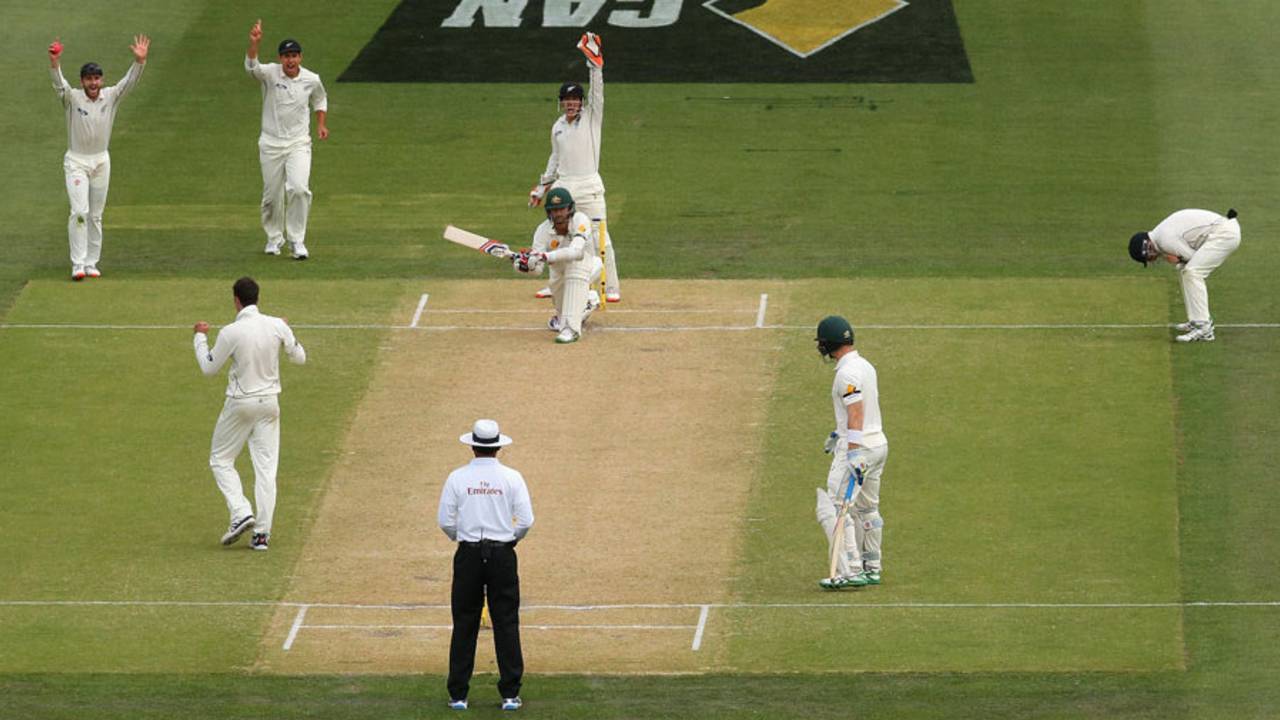Dodgy DRS throws New Zealand off course
Both captains couldn't have predicted how much a contentious DRS decision could affect the entire flow of a day's play and, possibly, the course of the Test
Melinda Farrell in Adelaide
28-Nov-2015
The DRS debate: Nathan Lyon was controversially given not out as Australia went on to add 106 crucial runs that could have a big impact on the Adelaide Test • Getty Images
In the lead up to this pink puzzle of a Test, both captains were asked about strategies they could employ to take advantage of the varying conditions as day turned into night and floodlights replaced sunshine.
Brendon McCullum mused about over-rates and controlling the tempo, while Steven Smith who acknowledged the pink ball's behaviour would vary, was less forthcoming on whether or not tactics would stray too far from those favoured in red ball cricket.
But neither captain would have predicted how much a contentious DRS decision could affect the entire flow of a day's play and, possibly, the course of this match.
The Test was progressing at a rapid rate when third umpire Nigel Llong gave Nathan Lyon a controversial reprieve.
Up to that point New Zealand's bowlers had done an admirable job of suffocating Australia, as their seamers bowled tightly and patiently through the afternoon - when conditions were favourable for batting. The impact of McCullum's tactic of spin from both ends was immediate as Mark Craig accounted for Smith and Peter Siddle in his second over, while Mitchell Santner bowled Josh Hazlewood soon after.
Australia had slumped to 8 for 116 from 5 for 109 when Lyon joined Peter Nevill at the crease. With uncertainty surrounding the fitness of Mitchell Starc, New Zealand must have been confident of coming in to bat with a decent amount of sunlight remaining when Santner's delivery appeared to graze Lyon's bat.
After Llong's decision, in the second over after tea, Australia added 106 runs and, of equal - if not greater - importance, ate up valuable hours of sunlight. Nevill and Lyon, who swept with the freedom of a condemned man given a last-gasp pardon, dismantled the attack, and once Lyon was removed, a hobbling Starc was even more devastating.
"That was the first time we knew Starc was going to come in, when Nevill stayed out there," said Ross Taylor. "We always thought we would try to hang in there and we were only a couple of wickets away. The new ball does a lot under lights if we were able to a bit longer in that middle session it might have made things a bit easier."
Taylor denied that New Zealand had dropped their heads, but it was evident their rattled attack fell flat and were perhaps guilty of not searching for wickets in their eagerness to avoid facing the new ball under lights. "We have got limited knowledge of the pink ball but we know it's going to do a bit more under lights and there's a bit of a glow around it," said Taylor. "It's a little harder to see at the start of your innings. Everyone knows it's going to do a little bit, how much, no one really knows."
The timing for the start of New Zealand's second innings could hardly have been worse and, as for Australia the previous night, the final session was a test of survival skills.
"We haven't really seen an older ball at that time of night," said Taylor, who managed 32 before being trapped lbw by Hazlewood. "If you have a 60-70 over ball, it won't do as much. When it got to 60 overs, when we bowled, it didn't do a lot. Anything upto 40-45 overs there's still quite a good shine on the ball and the bowling team has a pretty good chance of getting wickets. Survival is a big thing but you've also got to score some runs too."
Timing and light are likely to be just as crucial on day three, and New Zealand will be clock-watching as they attempt to build a defendable lead, whatever that may be.
"[There's] definitely no figure, but whatever we end up with we've got to get wickets," Taylor said. "Getting that new ball as close to twilight as possible. If we can keep our bowlers from not bowling as many overs tomorrow we give ourselves the best chance. Regardless of what happens we've got a couple of fighters out there and Hazlewood has to come back and bowl a few overs, hopefully he's not as potent. No team's been able to get to that second new ball."
As with so many factors in this experimental Test, while some pieces of the puzzle are falling in to place, the full picture has yet to emerge.
